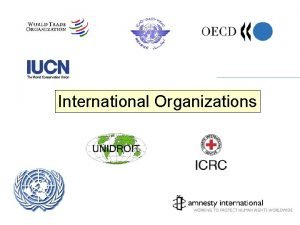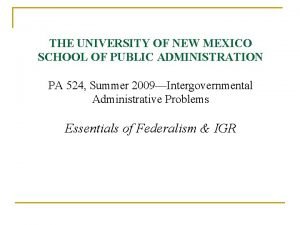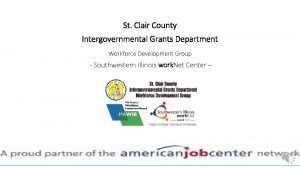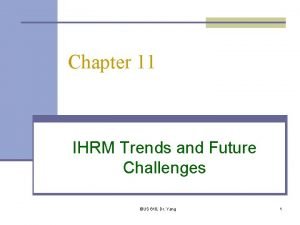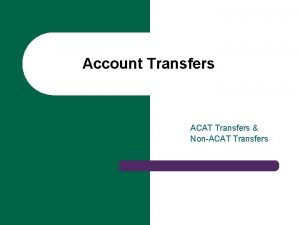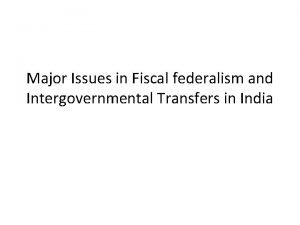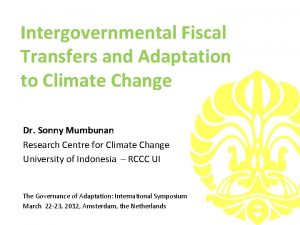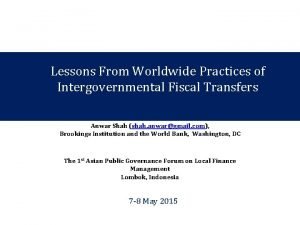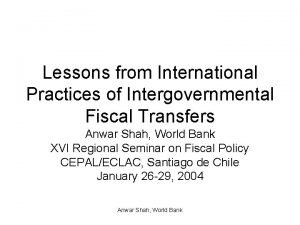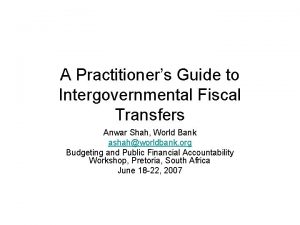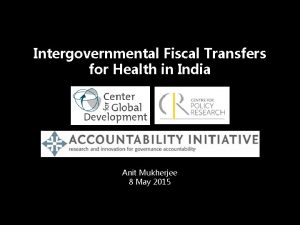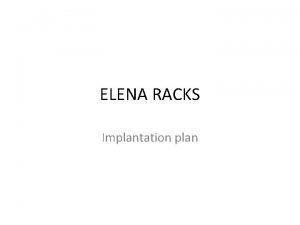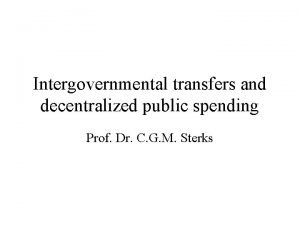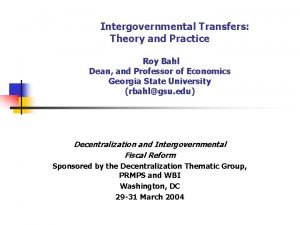Intergovernmental transfers current situation challenges and future Fiscal















- Slides: 15

Intergovernmental transfers current situation, challenges and future

Fiscal decentralisation, why? • • • LGAs play a major role in the implementation of the Mkukuta LGAs responsible for first line service delivery at local level Centrally collected revenue must be shared with all government levels in order for LGAs to implement their functions

Fiscal decentralisation, why? (2) • Intergovernmental transfers (IG) encourage councils priority setting to set their own priorities, i. e. , ownership • Ownership will enhance accountability • Enhance good governance

Present intergovernmental transfers (1) • More than 90 % of LG resources are from 3 types of IG transfers 1. Formula recurrent block grants (formula based) – Introduced 04/05 – Purpose • • • Enhance equity (ex. Education) enhance predictability enhance transparency – In practice not completely formula based

Present intergovernmental transfers (2) 2. Sector and project grants; combining both recurrent and development – – Education (PEDP) Health (Health basket) HIV/aids Roads 3. Development grants: LGCDG opportunity to mainstream sector grants • D by D assessments of sector budgets

Challenges (1) • In reality many IG are hard to follow

Education flows (source: PEFAR 2007)

Challenges (2) • • Multitude of channels Multitude of reporting requirements Unpredictability Budget structure not clear on actual allocation to LGA (esp. Development grants) • Complexity leads to weak demand of accountability

Challenges (3) • Allocations – – Determination of ceilings not strategic and transparent Allocations to LG unsufficient to comply with functions Allocations not respected Only 14% of development budget allocated to LG • So one could ask: where does the money gets stuck and why? • Formula’s are not always working (holding harmless)

Challenges (4) • LGAs not taken seriously? : – Late issuing of budget guidelines – Councillors not in a position to properly understand the proposed budget, due to its complexity and short notice – Non respect of local planning process and budgets • Leads to differences in budgets at LGA and Mo. F level • Reduces transparency and accountability to the public

Actual disbursements • Actual disbursements of IG as % of the budget 05/06 06/07 (up to December 31) Recurrent block grants PE OC 92% 43% 96 85 43 41 Sector baskets and subventions 82% 20% Development grants and funds 64% 18% (source: www. logintanzania. net)

Actual disbursements • Examples: – Mtwara districts received 2, 2 billion out of 4 billion for 05/06 (development) – Education transfers for development 06/07 is at 5, 8% – Health basket transfers consistently delayed, 3 rd plus 4 th arrived only recently

Implications • What does this mean in regards to the Mkukuta implementation • What does this imply in terms of selection of funding modalities in support of Mkukuta • What advise does this give for the redesign of the IG transfer system

What to do ? ? • simplify the IG system and thereby increase transparency (eg. Sectors in development grant system) • Budget process not in line with planning process; budget guidelines need to come out earlier (consequences for DPs) • Assure the actual funding flow of the budget • Assure the proper funding level of service delivery • Simplify reporting requirements

How • Intensive dialogue and support to Go. T : – Push for the operationalisation of the WG established as result of AR 06 This group should take initiative to: • Support revision of the IG system (support to Mo. F and PMORALG could push this process) • Simplify the reporting requirements (both Go. T and Donor requirements) • Elaborate measurable indicator for the PAF for measuring level of IG to LG level • Study optimal intergovernmental split to enhance service delivery at LG. Propose support to Go. T. – During AR PRBS 07 • Follow up AR PRBS 06; – working group (never met) – Target and progress for agreed indicator • Clear To. R for the above WG plus timeline. Establish process indicator. • Dialogue to assure that service delivery and development are properly funded and protected.
 Intergovernmental organization (igo)
Intergovernmental organization (igo) Intergovernmental child support
Intergovernmental child support Dual federalism definition ap gov
Dual federalism definition ap gov Deil wright models of intergovernmental relations
Deil wright models of intergovernmental relations Intergovernmental grants department
Intergovernmental grants department Future perfect simple and continuous
Future perfect simple and continuous Future perfect continuous and simple
Future perfect continuous and simple Examples of trends in media and information
Examples of trends in media and information Ihrm trends and future challenges
Ihrm trends and future challenges Future trends and challenges of hrm
Future trends and challenges of hrm Line currents
Line currents Power formula three phase
Power formula three phase Drift current and diffusion current
Drift current and diffusion current Line current and phase current
Line current and phase current Drift current density unit
Drift current density unit Intrinsic semiconductor
Intrinsic semiconductor
